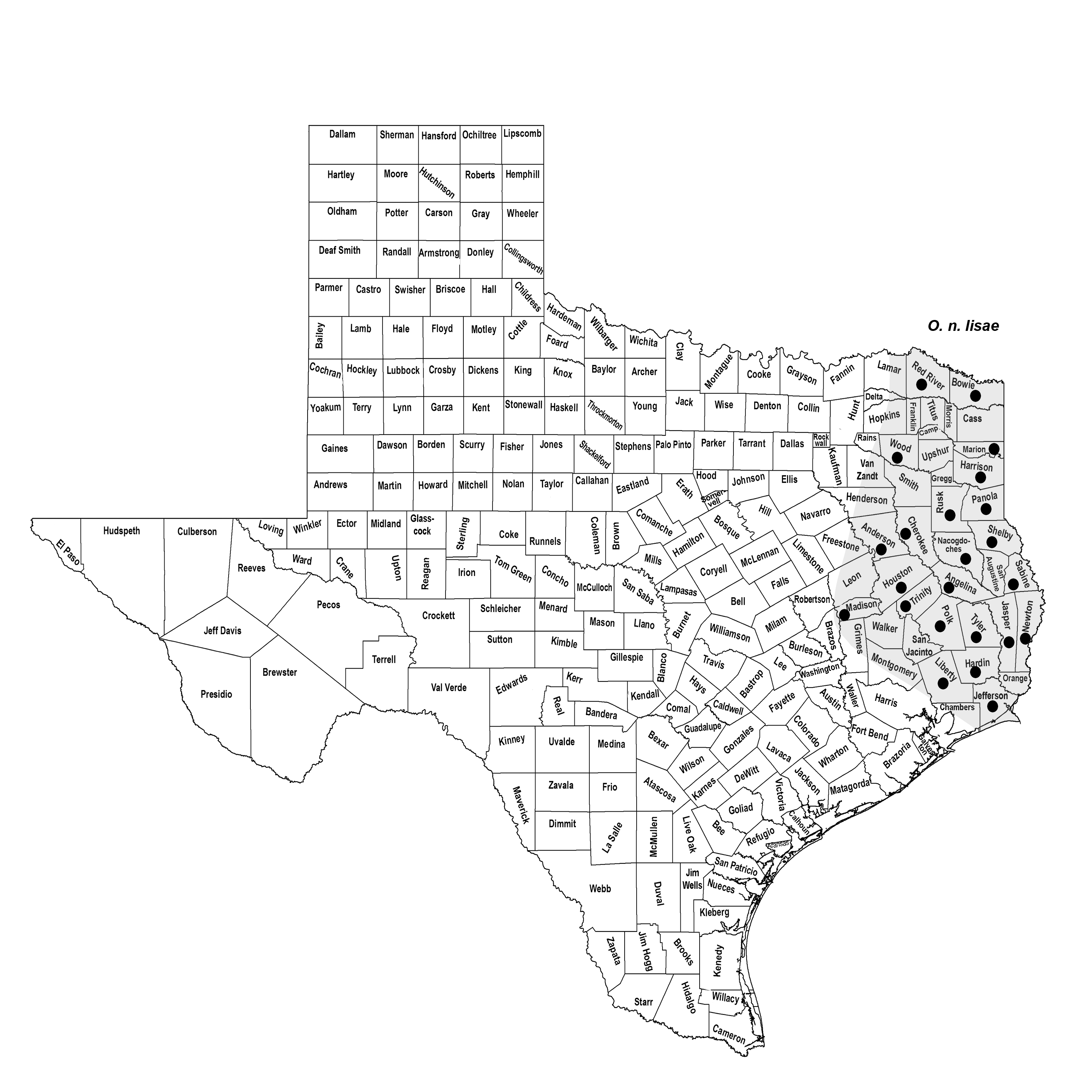GOLDEN MOUSE
Ochrotomys nuttalli (Harlan 1832)
Order Rodentia : Cricetidae
DESCRIPTION. A medium-sized, golden-colored (rich ochraceous tawny) white-footed mouse with soft, thick pelage; larger than the fulvous harvest mouse and without grooves on upper incisors; feet white; underparts pale cinnamon buff; tail brownish, darker above than below. Dental formula: I 1/1, C 0/0, Pm 0/0, M 3/3 × 2 = 16. Averages for external measurements: total length, 176 mm; tail, 78 mm; hind foot, 19 mm. Weight, 15–25 g.

DISTRIBUTION. Woodlands of eastern Texas.

SUBSPECIES. Ochrotomys n. lisae.
HABITS. These small, arboreal mice are adapted to and occur chiefly in forested areas. Tangles of trees, vines, and brush seem to be a preferred habitat. Specimens have been trapped on dark, wooded slopes where the mice lived in nests in tangles of grapevines; others were taken in an old pasture overgrown with blackberry, wild grape, and a few small trees. Near Bowie, two were taken in a hollow, fallen tree in river bottomlands; near Lufkin, one specimen was trapped in a pile of brush in hammock territory near the edge of the Angelina River bottom. Their nests are constructed of grasses, Spanish moss, or leaves and lined with shredded plant fibers or occasionally feathers; nests vary in size from the small brood nest about the size of a baseball to the large communal nests, as big as 20 × 30 cm, that may house half a dozen or more mice. One such nest housed eight individuals, all males. Usually the nests are placed in trees or bushes a few centimeters to 3 m above the ground; occasionally nests are on the ground under some protective cover such as a log, a stump, or a pile of brush, or they may be in cavities in standing trees.
Invertebrates make up about 50% of their diet. They also eat a variety of seeds, including
sumac, wild cherry, dogwood, greenbrier, poison ivy, and blackberry.
The breeding season begins in September and extends through winter and spring, with
little reproductive activity during summer. The peak breeding season is in winter.
Adult females may produce up to three litters annually. The young, ranging in number
from two to five (average three), are born following a gestation period of 25–30 days.
Newborn golden mice weigh about 2.7 g and are reddish with relatively smooth skin. The eyes and ears are closed at birth but open between 11 and 14 days of age. Weaning is completed at 3 weeks, and adult size is attained between the 8th and 10th weeks. The young mice are sexually mature 1–2 months after birth.
POPULATION STATUS. Uncommon. During fieldwork in Big Thicket National Preserve in the late 1970s and early 1980s, golden mice were commonly trapped in the wooded habitats throughout the preserve. However, few specimens of this mouse have been obtained during the last few decades in eastern Texas. In 2003 and 2004, Cody Edwards and Andy Bradstreet at Stephen F. Austin University studied golden mice in Nacogdoches and San Augustine counties and reported two viable populations. In addition, they provided information pertaining to the ecology and natural history of this species.
CONSERVATION STATUS. The IUCN lists the golden mouse as a species of least concern, and it does not appear on the federal or state lists of concerned species. Given the rarity of this species, there is a need to monitor populations and determine their conservation status.
From The Mammals of Texas, Seventh Edition by David J. Schmidly and Robert D. Bradley, copyright © 1994, 2004, 2016. Courtesy of the University of Texas Press.
Natural Science Research Laboratory
-
Address
Museum of Texas Tech University, 3301 4th street, Lubbock, TX 79409 -
Phone
806.742.2486 -
Email
nsrl.museum@ttu.edu

